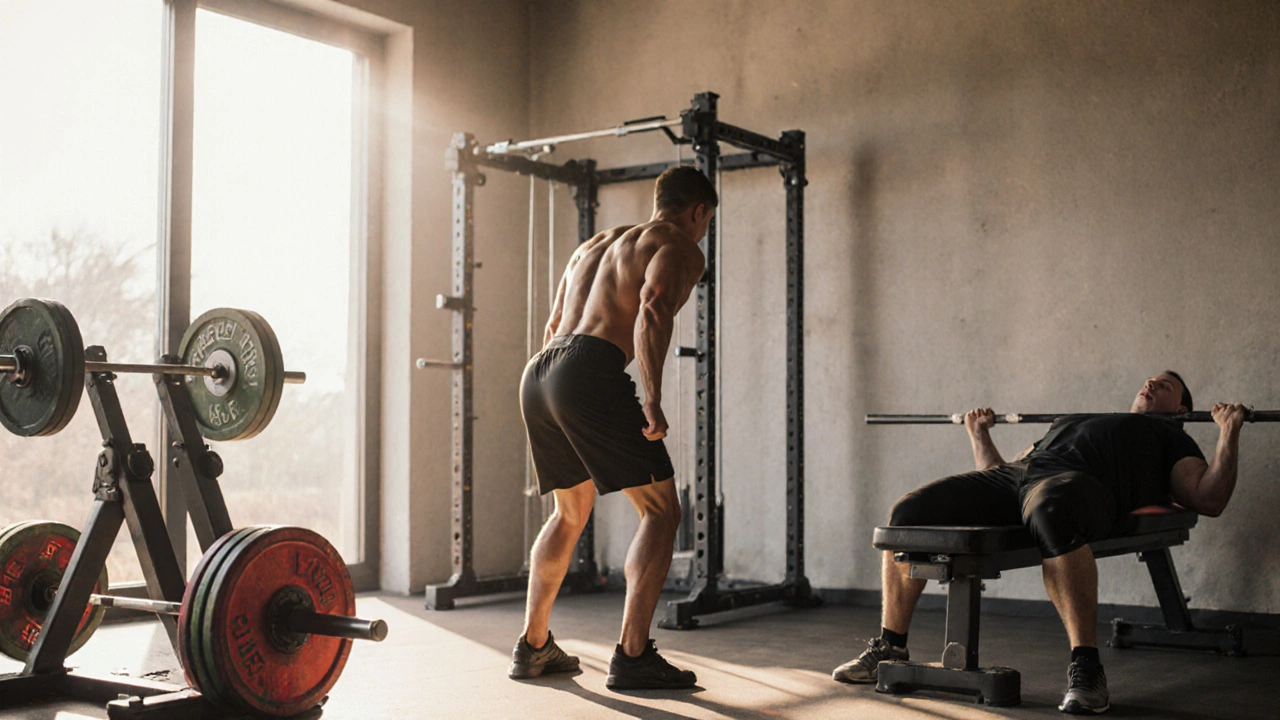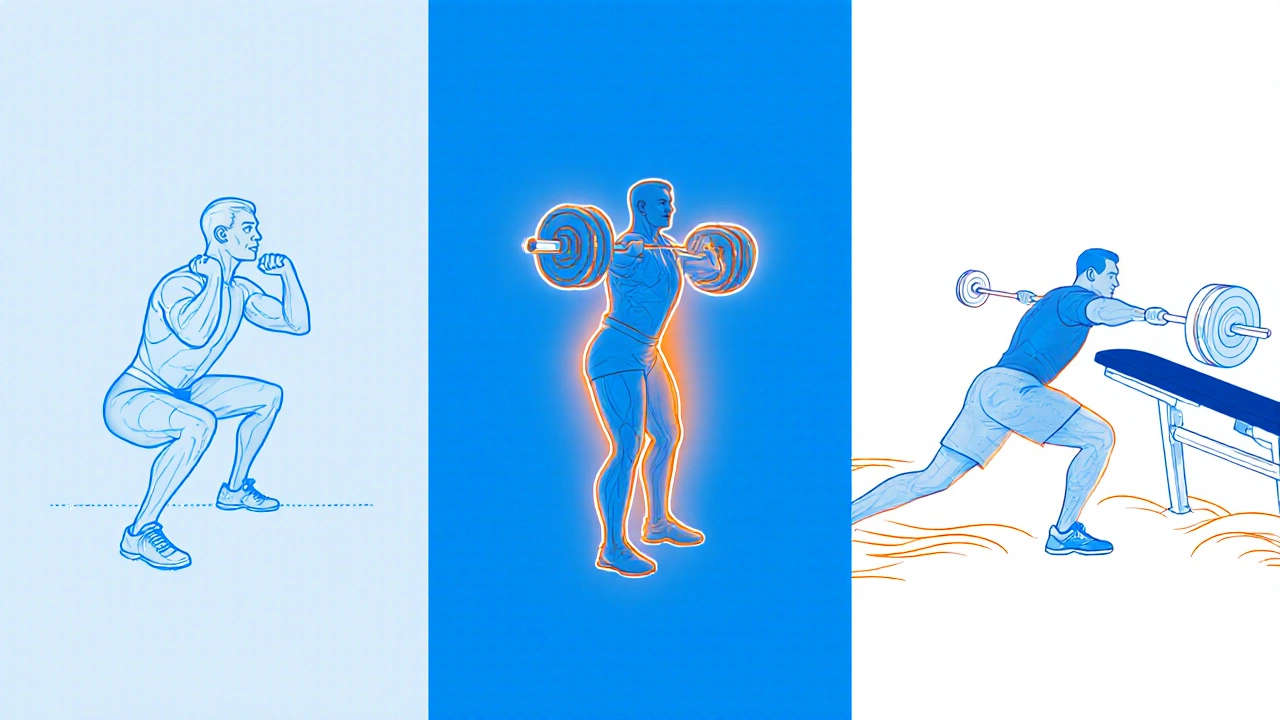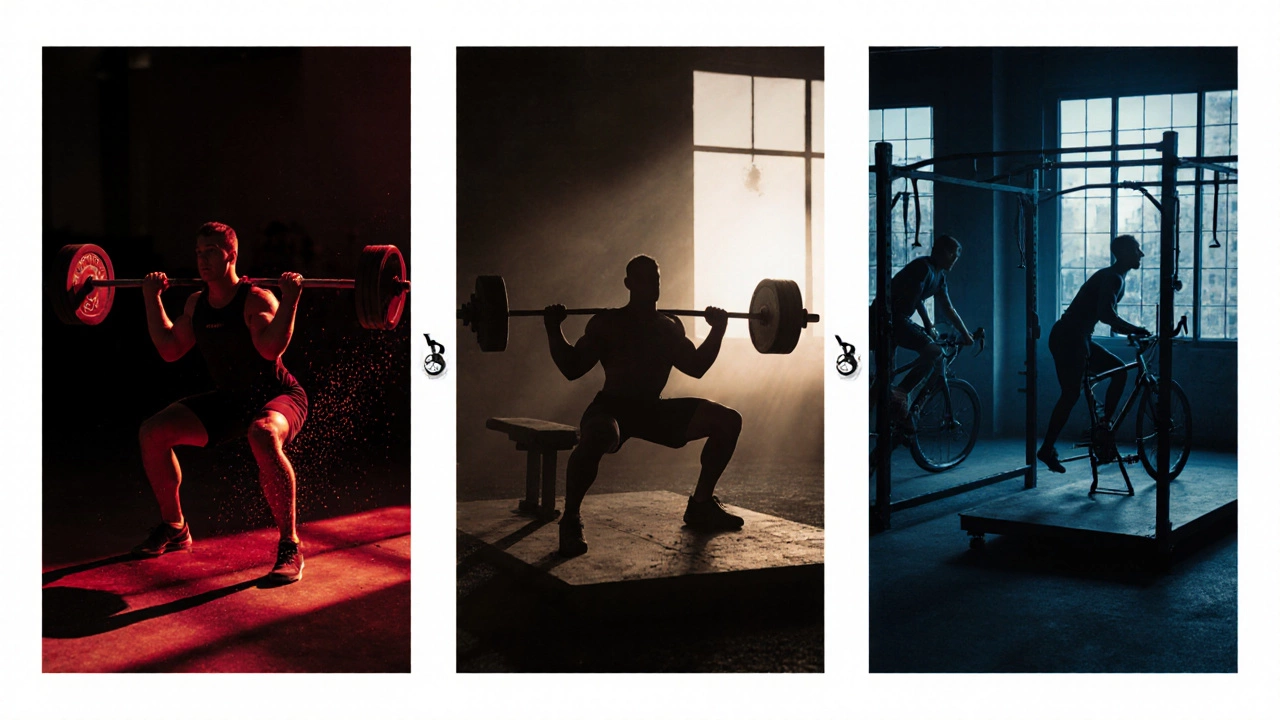Top 3 Essential Workouts for Full‑Body Fitness

3-Exercise Workout Planner
Create your personalized workout schedule based on the top 3 essential full-body exercises. Select your fitness level and frequency to generate a custom plan.
Your Personalized Workout Plan
Squat
Lower body compound movement
Deadlift
Full-body posterior chain exercise
Bench Press
Upper body push movement
Weekly Schedule
Day 1
Squat + Lower body accessories
Day 2
Bench Press + Upper body accessories
Day 3
Deadlift + Posterior chain accessories
How to track your progress
When you ask yourself "What are the 3 most important workouts?", you’re really looking for the moves that give you the biggest bang for your buck - the ones that build strength, improve posture, and keep your heart healthy without needing a fancy gym membership. Below you’ll find the three core exercises that cover every major muscle group, plus how to fit them into a routine that works for beginners and seasoned lifters alike.
Why these three movements matter
All three are essential workouts because they are compound, meaning they recruit multiple joints and muscle groups at once. That translates to more calories burned, greater functional strength, and faster skill transfer to everyday tasks like lifting groceries or playing with kids.
The three cornerstone moves
When structuring a balanced program, start with these foundational lifts:
- Squat is a lower‑body compound movement that primarily targets the quadriceps, glutes, hamstrings, and core while also enhancing joint stability.
- Deadlift is a full‑body pull that works the posterior chain - hamstrings, glutes, lower back, and traps - and teaches you how to lift safely from the ground.
- Bench Press is an upper‑body push that develops the chest, shoulders, and triceps, while also training shoulder stability and breathing control.
Together they hit every major muscle group, create hormonal responses that promote muscle growth, and improve coordination across the whole body.
How to perform each lift with proper form
Squat
- Stand with feet shoulder‑width apart, toes slightly turned out.
- Engage your core, keep the chest up, and push your hips back as if sitting on a chair.
- Descend until thighs are at least parallel to the floor; knees should track over the toes.
- Drive through the heels, extend hips and knees simultaneously, and return to standing.
Key tip: keep your weight on the mid‑foot, not on your toes, to protect the knees.
Deadlift
- Place the bar over the middle of your feet, about an inch from your shins.
- Hinge at the hips, push your hips back, and grab the bar just outside your knees.
- Set your shoulders back, spine neutral, and engage the lats by pulling the bar into your body.
- Drive through the heels, extend hips and knees together, and stand tall without hyper‑extending the lower back.
Key tip: think “push the floor away” rather than “pull the bar up” to keep the load on your posterior chain.
Bench Press
- Lie on a bench with feet flat on the floor; grip the bar slightly wider than shoulder‑width.
- Unrack the bar, keep elbows at about a 45‑degree angle from the torso.
- Lower the bar to the mid‑chest while maintaining a tight upper back and engaged core.
- Press the bar upward until arms are fully extended, keeping wrists straight.
Key tip: use a spotter or safety bars when loading heavy plates to avoid injury.

Building a weekly routine around the three lifts
Because each lift stresses different systems, you can schedule them three times a week with a rest day in between. Here’s a simple framework for beginners:
- Day 1 - Lower Body Focus: Squat (3 sets × 8‑10 reps) + accessory work like lunges or leg curls.
- Day 2 - Upper Body Push: Bench Press (3×8‑10) + push‑up variations and shoulder raises.
- Day 3 - Posterior Chain: Deadlift (3×6‑8) + rows or hyperextensions.
For intermediate lifters, rotate the order and add a second day of each lift (e.g., squat twice a week) while keeping volume moderate (4‑5 sets, 5‑6 reps) to stimulate strength gains.
Integrating cardio and mobility for holistic fitness
While the three lifts deliver strength, a well‑rounded program also includes cardio aerobic activity that improves heart health, increases endurance, and aids recovery. Aim for 150 minutes of moderate‑intensity cardio per week - brisk walking, cycling, or interval training - scheduled on off‑days or after the main lifts.
Mobility work prevents tightness that can derail form. Spend 5‑10 minutes each session on dynamic stretches (leg swings, arm circles) and finish with static holds for the hip flexors, hamstrings, and chest.
Progression strategies: from novice to seasoned athlete
Progressive overload is the cornerstone of improvement. Choose one of these simple methods:
- Increase weight: Add 2.5‑5kg (5‑10lb) to the bar each week when you can complete all reps with good form.
- Increase volume: Add an extra set before adding weight.
- Improve technique: Spend a session focusing solely on depth, bar path, or breathing.
When you hit a plateau for three weeks, switch the stimulus - for example, replace a standard squat with a front squat or pause deadlift - to challenge muscles in a new way.

Common mistakes and how to avoid them
Even experienced lifters slip up. Spot these red flags early:
- Rounded back on deadlifts: Indicates core disengagement; reduce weight and brace the core before trying again.
- Knees caving inward during squats: Strengthen the glutes and abductors with band walks.
- Elbows flaring too wide on bench press: Keeps shoulder joints safe; aim for a 45‑degree angle.
- Skipping warm‑up sets: Warm‑ups raise muscle temperature, reducing injury risk.
Keep a training log - note weight, reps, and any pain - so you can spot patterns and adjust early.
Quick comparison of the three core lifts
| Lift | Primary Muscles | Equipment Needed | Beginner Tip |
|---|---|---|---|
| Squat | Quadriceps, Glutes, Hamstrings, Core | Barbell or dumbbells, rack | Use a box or bench to gauge depth. |
| Deadlift | Hamstrings, Glutes, Lower Back, Traps | Barbell, plates, lifting platform | Start with a mixed‑stance (sumo) if flexibility is limited. |
| Bench Press | Chest, Shoulders, Triceps | Flat bench, barbell or dumbbells | Keep feet flat and shoulder blades retracted. |
Next steps for every fitness level
Absolute beginners: Master bodyweight versions first - air squats, hip‑hinge glute bridges, and push‑ups - before loading a bar. Aim for three sessions a week, focusing on movement quality.
Intermediate lifters: Add the barbell versions, keep the weekly split outlined above, and start tracking progressive overload.
Advanced athletes: Incorporate variation lifts (front squat, deficit deadlift, incline bench), periodize your training into 4‑week blocks, and consider sport‑specific conditioning.
Frequently Asked Questions
Can I do these lifts without a gym?
Yes. For squats and deadlifts you can use a sturdy backpack filled with books or a kettlebell. A simple bench or even the floor works for push‑ups that mimic the bench press movement.
How many times a week should I train each lift?
Beginners benefit from once a week per lift to recover. Intermediate lifters can move to twice a week, spacing sessions 48‑72 hours apart. Advanced athletes may train each lift up to three times in a periodized program.
What’s the safest way to add weight?
Add the smallest available increment - typically 2.5kg (5lb) on each side - and only increase when you can perform every rep with perfect form for two consecutive sessions.
Should I do cardio on the same days as strength training?
It’s fine to do low‑intensity cardio (20‑30minutes) after lifting if you’re short on time. For high‑intensity interval training, schedule it on separate days to keep strength gains optimal.
How long will it take to see results?
Most beginners notice strength improvements within 2‑4 weeks and visible muscle changes after 6‑8 weeks, provided they train consistently and follow a balanced nutrition plan.